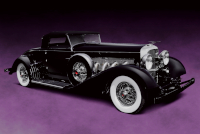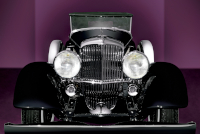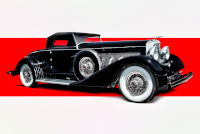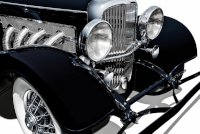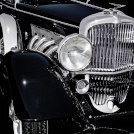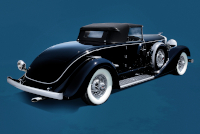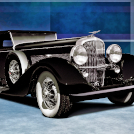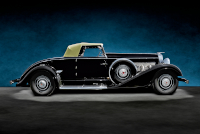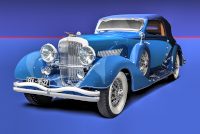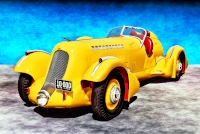Location:
Elegance at Hershey, 2017
Owner: Harry Yeaggy | Cincinnati, Ohio
Prologue:
Noteworthy for its Best of Show at Amelia Island in 2018, we spotted J-240 at Hershey the year before. For a car finished in black, I was most intrigued by its tendency to shade into the red end of the spectrum. Many of the original shots evoked a deep plum in the paintwork (photos 1 and 2), whereas others reflected blues and violets, as one would expect. I decided to defy the blackness of the car and follow these different tonal suggestions to create a more colorful gallery. I'm most happy with the pipes portrait (5), which is an eye-pleasing blend of fantasy and reality.
In researching J-240, I happened across two period photographs posted by The Old Motor depicting the car after its Bohman & Schwartz update. Of these images, a profile shows the car wearing wheel covers and a light-colored hood. Coincidentally, I had snapped a profile of J-240, and while not very keen on the original image, the similarity provides a means to illustrate that period photograph anew. So image 10 depicts what J-240 would have looked like in the mid to late 1930s if rolled into a digital photography studio.
- - - - - - - - - -
► Image Source: Nikon D750 (24.3 MP)
References:
- Automobile Quarterly, Volume 30, Number 4, Summer 1992, "The Crowning Touch: Custom Coachwork for the Model J" by David Holls, The Kutztown Publishing Company, Inc., Kutztown, PA, page 67
- The Old Motor: A couple period photos show J-240 fresh from its Bohman & Schwartz reconfiguration. The photographs come from the Fred Roe collection, of Duesenberg publications noted in this collection, and the profile serves as the basis for our period re-creation.
- UltimateCarPage: For comparison, a look at J-530, a Walker La Grande Convertible Coupe. Work by Wouter Melissen, September 28, 2015.
- Hemmings: A quick write-up on the Best of Show winners from the 2018 Amelia Island Concours d'Elegance.
- Wikipedia: The sordid history of Edward Beale McLean.
- Wikipedia: Loosely related history on the Hope diamond.
J-240 began life in 1929 as a Murphy Convertible Coupe, which, for the otherwise remarkable Model J, would be the standard coachwork complement in the sense that a large number of early Model J cars are Murphy convertibles. But in 1937, this car (chassis #2268) went to Bohman & Schwartz of Pasadena California, where it received updated styling. Under the bonnet, motor J-240 received an upgraded dual-carburetor intake and centrifugal supercharger, converting the J to SJ specification.
Edward Beale McLean, a Duesenberg, and Too Much of Everything
Early in its history, Edward "Ned" Beale McLean owned J-240. His is a name of some importance to those of us in the mid-Atlantic. In particular, as I've worked in the northern Virginia tech corridor and traveled across the McLean Metro stop countless times, discovering the McLean origin story in the history of this Duesenberg is a bit of a surprise. Edward Beale McLean was the only son of John Roll McLean and grandson of Washington McLean, who, through two generations of father-son cooperation, purchased the Cincinnati Enquirer and the Washington Post. John Roll McLean also established the Great Falls and Old Dominion Railroad, along with Senator Stephen Benton Elkins. Thus, the northern Virginia town of McLean takes its name from John Roll McLean, having been developed in the early 20th century along the rail line.
As to the grandson, Edward Beale McLean seems best known by history as an epic spender. Most interesting among his purchases, in 1911 McLean bought the Hope diamond from Cartier Jewelers in New York for the reported sum of $180,000. A quick currency calculation suggests this purchase is the equivalent of $4.8 million in today's money. In 1916, Edward inherited The Washington Post and would maintain ownership until 1933, at which point his penchant for spending would see court-appointed trustees sell the newspaper through bankruptcy. Eugene Meyer, recently Chairman of the Federal Reserve, purchased the paper for $825,000. By October of the same year, a Maryland court declared Edward Beale McLean legally insane.
There are, of course, plenty of anecdotes describing Edward's behavioral antics, romantic affairs, and financial insouciance, not the least of which is his role in the Teapot Dome scandal. But his story ends somewhat predictably at Baltimore's Sheppard Pratt hospital, one of the oldest mental institutions in the country. Being a native Baltimorean, I grew up well acquainted with stories of Sheppard Pratt, having known people who both worked there and resided there, which is why I say this ending is predictable. Edward died at Sheppard Pratt in 1941. The Hope diamond now resides in the Smithsonian National Museum of Natural History, having been donated by jeweler Harry Winston in 1958.
Tracing the history of Edward Beale McLean and his liaisons in and around Washington DC, Wikipedia sourced a poignant quote from a March 12, 1911 New York Times article titled, "M'LEANS DIDN'T KNOW HOPE DIAMOND TALE; Wealthy Couple Unaware That the Famous Gem Had Brought Misfortune to Its Owners." The quote reads, "Both Ned McLean and his pretty wife are quite young, and in a way unsophisticated, although they were born and reared in an atmosphere of wealth and luxury. All their lives they have known more of jewelry, finery, banquets, automobiles, horses, and other articles of pleasure than they have of books, with their wealth of knowledge." So we come full circle to the point of our article, Duesenberg J-240, and that its place in the McLean estate is hardly important. In many cases, we actually care about who owned the car and why. But in this case, the Duesenberg seems piddling in comparison with the weight of its surrounding excess.
Motor: 6,876 cc straight 8-cylinder, cast iron block and head | 95.3 mm x 120.7 mm | 5.2:1 compression
Valvetrain: DOHC, 4 valves per cylinder
Aspiration: dual two-barrel updraft carburetors, centrifugal supercharger
Power: 320 bhp at 4,200 rpm
Drivetrain: Warner 3-speed manual gearbox, rear-wheel drive
Front Suspension: solid axle with semi-elliptic leafsprings and hydraulic shock abosorbers
Rear Suspension: live axle with semi-elliptic leafsprings and hydraulic shock absorbers
Architecture: steel ladder-frame chassis with coachwork by Murphy and Bohman & Schwartz, both of Pasadena, California
Wheelbase: 3,620 mm (142.5 inches)
Etymology:
The 'S' designation applies retroactively to the Model J, denoting the addition of a supercharger. In this case, we use the term 'J/SJ' to note that the car began life in 1929 as a normally aspirated J, and was uprated to SJ-specification in 1937. The 'J-240' designation is the motor number. Unlike most automobiles, devotees refer to Duesenbergs by motor, rather than chassis.
Figures:
A defunct index listed more than 460 Model J Duesenbergs known to circulate in public. The factory produced perhaps closer to 490 originally. Of early Model J cars, many received Murphy coachwork. AQ notes that Bohman & Schwartz completed four bodies in period for the Model J, one of which is in fact a Murphy design (J-572). This reconfiguration by Bohman & Schwartz builds a unique example of the car, though not far from common style trends of the mid-1930s.
Not Packard: Comparison of J-240 with Contemporary Raymond Dietrich Design
Bohman & Schwartz extended the bonnet to the windscreen, which is a remarkable trick to elongate the nose as much as possible. The coachbuilder reshaped the rear deck, fitted single-bar bumpers, and prepared a more modern set of running gear. Between the extended bonnet, linear chrome, and skirted fenders, the design mimicks the styling devices best known to Raymond Dietrich's Eleven and Twelve-series Packards, circa 1933-34, with a nod to Alexis de Sakhnoffsky in the tromp l'oeil styling that makes the car appear so long and smooth. This much is supposition, but it's reasonable to suspect that Bohman & Schwartz took a few cues from Packard's motor show stage when embellishing the original Murphy coachwork.
Less like a Packard, the 1937 refurbishment included a supercharged SJ upgrade, necessitating external exhaust pipes and a set of bonnet side screens in place of what would have been louvres.
Boat Deck: Similarities between Duesenberg J-240 and J-530
Quite elegant from the tail, the extended rear deck wears a single wrap-around chrome strip, fit like a tuxedo to the simple, fluid shape. The deep paint, skirted fenders, and deep running boards cloak the flanks, adding to the car's pleasure-craft stature. Staying within the Duesenberg family, J-240 resembles J-530, a Walker La Grande Convertible Coupe from 1934. Between the two, J-530 retains more typical Duesenberg character, particularly in its running gear, painted wheel covers, and Art Deco brightwork. By following popular trends, this Bohman & Schwartz sits a bit lower and feels a bit heavier.
Wheel Discs: A Period Reconstruction of Duesenberg J-240 circa 1937
Period photographs at The Old Motor show recently refurbished J-240 with and without wheel discs, probably around 1937. The car has also appeared on the modern concours scene wearing similar, though not identical wheel discs. The last image in our gallery illustrates J-240 as it appeared in the late 1930s using the original disc wheel covers and a lighter hood.
Last Updated: Mar 26, 2025

